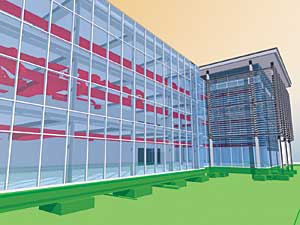Transformative Tools Start to Take Hold
Learning Objectives:
- Define what a building information model is.
- Explain the benefits of using building information modeling (BIM).
- Discuss how BIM can be used in design and construction.
Credits:
No doubt you've already heard a great deal about the digitally enabled revolution that promises to transform design and construction. Proponents say that if the industry embraces building information modeling, or BIM, it will streamline the delivery process, ensure well-coordinated documents, providing a basis for more accurate fabrication and construction. Designs will be more closely tied to structural analysis and energy simulations, producing better performing, higher-quality facilities. These will be built more quickly and at lower cost than previously possible, resulting in fewer claims, and of course, happier clients.
So exactly what is this panacea for all that ails the design and construction industry? At the heart of the new process is the building information model-an object- oriented digital representation of a building. Unlike traditional two-dimensional CAD drawings, the model is not a collection of discrete lines on the screen, but is a compilation of integrated and dynamic data that describes the functional and physical aspects of a building and its components. This model could include information such as the dimensions and structural characteristics of beams, the fire rating of partitions, or warranties for mechanical equipment.
More than a new way of drafting, BIM is really a paradigm shift for design and construction. Its adoption forces examination of a host of practice and business issues, from the definition of professional roles to liability to project delivery methods. Perhaps because of these still-emerging concerns, BIM is not yet mainstream. According to the most recent American Institute of Architects' firms survey, The Business of Architecture, about 16 percent of firms have acquired BIM tools, and roughly 10 percent are using them for billable work. However, among firms with 50 or more employees, just over 60 percent have acquired BIM software, and just over half are using it on billable projects. Adoption is likely now more widespread since the data, collected in the spring of 2006, is already eons old in the context of a rapidly evolving technology.
|
||||
Even for large, technologically sophisticated firms, it isn't all BIM all the time. "While we are using 3D modeling on just about everything, we aren't at that level just yet for BIM," says NBBJ managing partner Jim Jonassen, FAIA. Jonassen says the firm has been pursuing object-based design for about a decade, with just over half of its current projects using BIM. His goal is for 75 percent of the firm's projects to be using the process by the year's end.
Just how comprehensively the technology is being used varies from project to project and team to team. A whole spectrum of deployment is possible. Some architects and consultants are using BIM only within their own offices and distribute 2D background documents to other members of the team. On other projects, 3D models are shared with fabricators and constructors. Some contractors are creating their own building information models from their designers' traditional CAD drawings. Sources say that there are still benefits, even when only one member of a project team is working in a BIM environment. "If we are the only ones using the process, it still improves the quality of the product and our efficiency," says Jim Jacobi, C.I.O. of structural engineering firm Walter P Moore. However, "You can come as close as possible to flawless delivery when all the partners in the supply chain engage," he adds.
With large owners like the General Services Administration (GSA) jumping on the BIM bandwagon, use of the technology by all members of the design and construction team will surely grow. Since 2003, the agency has been exploring aspects of BIM, including energy simulation, materials quantity analysis, and construction scheduling, on select pilot projects. But starting with this fiscal year, funded projects are required, at minimum, to provide "spatial program building information models" as part of their schemes. The spatial models will be used to evaluate how well proposals meet programming requirements.











